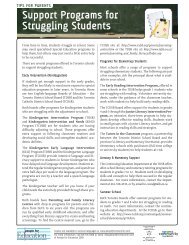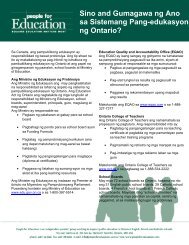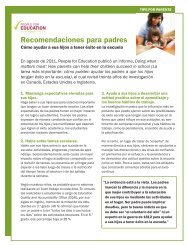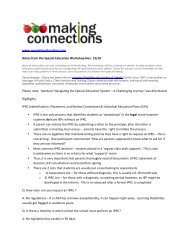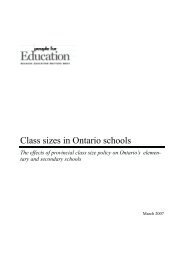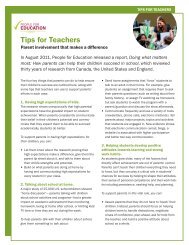Our Children Our Future Our Vision - People for Education
Our Children Our Future Our Vision - People for Education
Our Children Our Future Our Vision - People for Education
Create successful ePaper yourself
Turn your PDF publications into a flip-book with our unique Google optimized e-Paper software.
<strong>Our</strong> <strong>Children</strong>, <strong>Our</strong> <strong>Future</strong>, <strong>Our</strong> <strong>Vision</strong><br />
ing the system and ensuring the conditions are in place to support student success,” as well as inadequate<br />
compensation to retain qualified staff. The Curve Lake submission expanded on the issue<br />
of retaining qualified staff to raise the concern that the training expenses incurred <strong>for</strong> new teachers<br />
on reserve are often lost to the community when teachers leave <strong>for</strong> better paying positions elsewhere.<br />
Curve Lake also commented that “para-professional services, such as speech, psychological<br />
testing, are expensive and difficult to acquire at the local level.”<br />
The OTC specifically expressed the need <strong>for</strong> increased salaries of Anishinaabemowin teachers and<br />
advocated <strong>for</strong> “an effective lobbying strategy to address the inadequate funding that presently exists<br />
<strong>for</strong> Anishinaabemowin initiatives.” The Tribal Council also focused on post-secondary funding<br />
issues and pointed to current student waiting lists as a consequence of the 2% cap and underfunding.<br />
The proposed third party administrative change <strong>for</strong> post-secondary funding was also highlighted<br />
as an area of concern.<br />
First Nation jurisdiction over education was a principal concern of both ONECA and AIAI. ONECA<br />
“supports the implementation of mechanisms which will implement First Nations jurisdiction to<br />
govern education systems, establish standards which ensure high quality culturally and linguistically<br />
relevant education, and which affirm predictable and necessary funding to enable the operation<br />
of First Nation <strong>Education</strong> systems.” AIAI asserted that their “member Nations’ position is to<br />
affirm First Nations jurisdiction over their education systems. The federal government must legally<br />
recognize First Nations governance and service delivery systems.” AIAI furthermore relates First<br />
Nations inherent right to self-government directly in support of First Nations control of First Nations<br />
education.<br />
Rights were considered closely related to the education issues outlined in the written submissions.<br />
ONECA stated that “First Nation students have a right to a quality and comparable standard of<br />
education as offered in Canada’s provincial schools systems” and that “First Nation <strong>Education</strong>al<br />
authorities have the right to establish their own educational systems and institutions.” OPSBA<br />
pointed to the United Nations Declaration on the Rights of Indigenous <strong>People</strong>s, to which Canada is<br />
a signatory, as a “framework <strong>for</strong> developing any directions undertaken to establish conditions <strong>for</strong><br />
equitable education opportunities <strong>for</strong> First Nation children and youth.” Curve Lake spoke to jurisdiction<br />
and Treaty rights in the statement; “[t]he federal government needs to improve the self-government<br />
of education and acknowledge the treaty right of all First Nation members to better than<br />
adequate elementary and secondary education.”<br />
The majority of submissions also made reference to the importance of language and culture <strong>for</strong><br />
First Nation education. The OTC determined that language and culture was one of their highest<br />
priorities this year. Curve Lake highlighted the importance of ensuring local control to incorporate<br />
local content and language dialect in order to maintain and/or revitalize the culture and language<br />
of the community. This is a significant source of enabling students to gain knowledge of who they<br />
are and where they fit into the local and broader community.<br />
Chiefs of Ontario<br />
78




